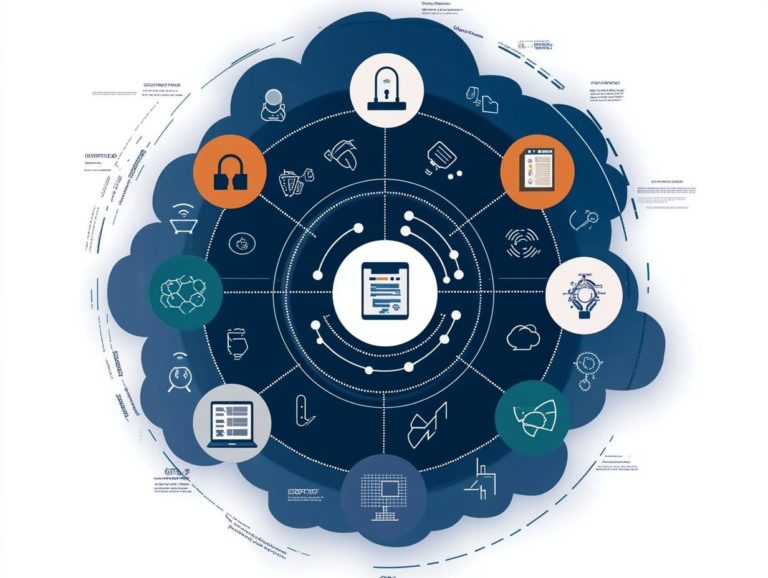How to Implement Cloud Security Best Practices
As businesses rely on cloud services for data storage and operations, understanding cloud security is crucial.
This article explores the fundamentals of cloud security, emphasizing its significance and the advantages of adopting best practices. It discusses common threats and vulnerabilities organizations face in the cloud environment, along with effective strategies to protect sensitive information.
From carefully configuring services to ensuring compliance with regulations, this guide provides you with the expertise to safeguard your digital assets.
Contents
- Key Takeaways:
- Understanding Cloud Security
- Importance of Implementing Best Practices
- Common Cloud Security Threats
- Best Practices for Cloud Security
- Monitoring and Auditing Cloud Activity
- Considerations for Cloud Security
- Frequently Asked Questions
- How can I ensure the security of my data in the cloud?
- What are some common threats to cloud security?
- What are the benefits of implementing cloud security best practices?
- Want to empower your team with cloud security skills? Here’s how!
- What are some key components of a cloud security plan?
- How often should I review and update my cloud security practices?
Key Takeaways:

Proper implementation of cloud security best practices is crucial for protecting sensitive data and preventing cyber attacks. To learn more about this important topic, check out our guide on how to manage cloud security risks effectively. Securely configuring cloud services, implementing multi-factor authentication, and regularly updating systems are key practices for maintaining strong cloud security.
Important factors for cloud security are choosing a reliable provider, complying with regulatory requirements, and ensuring ongoing security measures are in place.
Understanding Cloud Security
Understanding cloud security is vital for your organization as you work to protect data and meet compliance standards.
With the rapid rise in cloud service adoption, you must implement strong security measures, including understanding the key features of a cloud security strategy, to protect sensitive information stored in cloud environments.
Cloud security involves various strategies, such as encryption, access management, and incident response plans, all essential for mitigating the risks of data breaches and ensuring data integrity.
As you navigate the shared responsibility model with your cloud providers, effective risk management will significantly enhance your overall security posture.
What is Cloud Security?
Cloud security consists of policies, technologies, and controls designed to protect your cloud-based systems, data, and infrastructure from various threats and vulnerabilities.
This strategy includes important tools like encryption, which safeguard sensitive information during both transmission and storage. Implementing robust security protocols is vital to ensure that communications within your cloud environment remain confidential and intact.
Adhering to established cybersecurity standards is also critical, as it helps you comply with legal and regulatory requirements. By integrating these essential elements, you can greatly enhance your defenses against potential cyber threats, ensuring that your cloud services are resilient while maintaining the integrity and availability of your data.
Importance of Implementing Best Practices
Implementing best practices in cloud security is essential to safeguard your data, ensure compliance, and effectively mitigate risks.
By following recognized security frameworks and policies, you can improve your organization s security posture and significantly reduce the likelihood of data breaches.
Benefits of Proper Cloud Security
Proper cloud security provides numerous benefits, from enhanced data protection to improved incident management and compliance with industry regulations.
By implementing strong cloud security measures, you can elevate your overall security visibility. This visibility is key for identifying potential threats early, allowing you to respond proactively before issues escalate.
Using advanced monitoring tools enables real-time analysis, crucial for maintaining stringent cybersecurity standards. Regular security audits further strengthen these efforts, ensuring that your safeguards are effective and current.
As a result, you not only reduce the risk of data breaches but also build greater confidence among stakeholders, knowing their sensitive information is protected by comprehensive measures.
Common Cloud Security Threats

Cloud security threats are diverse and constantly evolving, posing significant risks for organizations using cloud services.
You face common threats like data breaches, DDoS (Distributed Denial of Service) attacks, and misconfiguration issues, all of which can lead to considerable financial losses and reputational damage.
It’s essential to remain vigilant and proactive in addressing these challenges.
Types of Attacks and Vulnerabilities
Types of attacks and vulnerabilities in cloud security include phishing, credential theft, and insecure APIs. Each of these poses a significant threat that could lead to data breaches and serious security issues.
In today s interconnected digital landscape, these threats emphasize the need for robust security controls and effective identity management strategies.
Make regular penetration testing a priority. This involves testing your system to find weaknesses before someone else does. Collaborating with third-party specialists can enhance your security posture by providing expert insights into the latest threats.
Continuous security assessments not only mitigate risks but also help ensure compliance with industry regulations. By addressing these vulnerabilities proactively, you can better protect your sensitive data and maintain trust with your clients and stakeholders.
Best Practices for Cloud Security
Implementing best practices for hybrid cloud security is essential to protect your data and ensure compliance with regulatory standards.
- Robust employee training
- Routine security audits
- Well-crafted incident response plans
By prioritizing these strategies, you can strengthen your organization’s defenses and navigate the complexities of SaaS security best practices with confidence.
Securely Configuring Cloud Services
Securely configuring your cloud services is essential for preventing misconfiguration issues that could expose sensitive data and lead to security breaches.
First, establish clear security policies that dictate how your services will be set up, utilized, and monitored. Create a structured approach to access management, ensuring that only authorized personnel can make changes to configurations or access sensitive information.
Implement regular monitoring procedures, focusing on auditing access logs and configurations to detect any anomalies. Using multi-factor authentication and role-based access can significantly mitigate risks.
Ultimately, adopting a proactive approach to cloud security not only protects sensitive information but also instills confidence among your users and stakeholders.
Implementing Multi-Factor Authentication
Implementing multi-factor authentication (MFA) is a crucial step in enhancing access management and ensuring compliance with cybersecurity standards.
This robust security technique requires you to provide multiple forms of identification before accessing sensitive data. By integrating MFA into your identity management practices, you can significantly reduce the risk of unauthorized access to your cloud services.
The process typically combines something you know, like a password, with something you have, such as a smartphone app that generates one-time codes. This layered approach not only strengthens your security but also builds trust among your users, ensuring their personal information remains protected in an increasingly digital landscape.
Regularly Updating and Patching Systems

Regularly updating and patching your systems is essential for maintaining cloud security and addressing vulnerabilities that could expose your data to cyber threats.
By adopting a systematic approach to these updates, you can manage the risks associated with software vulnerabilities. Conduct thorough vulnerability assessments to identify weaknesses and prioritize them for timely patches.
This not only strengthens your defenses against potential cyberattacks but also aligns with your overall risk management strategies. Leveraging advanced security protocols and monitoring tools enhances your visibility into system health, allowing you to respond swiftly when new vulnerabilities arise.
Ultimately, this cohesive strategy fortifies your cloud environments against ever-evolving threats. Don’t wait until it’s too late; start implementing PaaS security best practices today!
Monitoring and Auditing Cloud Activity
Monitoring and auditing your cloud activity are essential practices that provide invaluable security visibility. They enable prompt responses to any potential security threats.
These activities typically employ a range of sophisticated tools, including SIEM (Security Information and Event Management) systems. These systems aggregate and analyze security logs from various cloud services.
By leveraging such tools, you can gain comprehensive insights into the performance and security posture of your cloud environment. Automated monitoring solutions continuously track access patterns, user behavior, and system vulnerabilities, helping you identify anomalies that might signal a breach.
Integrating real-time alerts into your incident management processes ensures that your security team can swiftly address threats, minimizing downtime and potential data loss.
Using these methods effectively not only enhances compliance but also bolsters the overall integrity and resilience of your cloud infrastructure.
Considerations for Cloud Security
When evaluating cloud security, several key considerations must be addressed to ensure adequate protection of sensitive data and compliance with industry standards.
Choosing a Reliable Cloud Provider
Choosing a reliable cloud provider is essential for your organization s security and compliance regarding cloud services.
As you navigate the landscape of cloud solutions, pay close attention to several key factors:
-
First and foremost, the security solutions offered by a provider are crucial. Strong encryption protocols and multi-factor authentication significantly mitigate the risks associated with data breaches.
-
Next, consider the compliance features of the cloud provider. Their offerings should align with industry regulations like GDPR, HIPAA, or PCI-DSS, ensuring their data handling practices meet legal requirements.
-
Lastly, don t overlook the incident management processes in place. Understanding how a provider responds to security incidents gives valuable insights into their readiness and reliability, ultimately fostering greater confidence in protecting your sensitive information.
Compliance and Regulatory Requirements
Compliance with regulatory requirements is crucial for organizations utilizing cloud services, as it ensures adherence to industry standards and effective risk management.
You need to navigate a complex landscape of compliance frameworks such as GDPR, HIPAA, and ISO 27001. Each presents unique requirements that guide your cloud security practices.
Understanding the implications of these regulations is critical; failure to comply could result in severe financial penalties and reputational harm.
Implementing robust security measures aligned with these standards not only protects sensitive data but also builds trust with your customers and stakeholders.
Maintaining compliance showcases your commitment to safeguarding information, enhances your competitive advantage in a crowded market, and fosters an environment of accountability and transparency.
Ensuring Ongoing Cloud Security

Ensuring ongoing cloud security is essential for continuously protecting your data and adapting to ever-evolving threats in the digital landscape. To achieve this, implement a series of strategic measures, starting with regular security audits that thoroughly assess your existing cloud infrastructure for vulnerabilities, while avoiding the top 10 mistakes in cloud security implementation.
Developing a robust incident response plan is also crucial; this enables your teams to act swiftly in the event of a security breach, minimizing damage and downtime.
Continuous risk mitigation efforts, such as keeping your software up to date and employing encryption for sensitive information, are vital for safeguarding your assets. By incorporating these practices into your operations, you can fortify your defenses and maintain a resilient cloud environment.
Frequently Asked Questions
How can I ensure the security of my data in the cloud?
Secure your cloud data by following best practices, which include understanding the key elements of a cloud security strategy. Regularly update security measures and limit access to sensitive information.
Implement strong authentication measures. Encrypt your data and back it up regularly. These steps are crucial for protecting cloud applications from threats.
What are some common threats to cloud security?
Common threats to cloud security include data breaches, data loss, unauthorized access, and denial of service attacks.
These threats may arise from weak passwords, misconfigured security settings, and inadequate security measures.
What are the benefits of implementing cloud security best practices?
Using cloud security best practices protects your data from cyber attacks.
It ensures compliance with regulations, reduces downtime risk, and increases your cloud environment’s overall security and reliability.
Want to empower your team with cloud security skills? Here’s how!
Train your employees by providing regular training sessions and creating clear security policies.
Conduct simulated security drills to reinforce proper protocols. Regularly communicate updates on security procedures.
What are some key components of a cloud security plan?
A cloud security plan should include strong authentication measures, regular security audits, data encryption, and disaster recovery protocols.
It should also define roles and responsibilities for managing security and outline procedures for incident response and risk management.
How often should I review and update my cloud security practices?
Review and update your cloud security practices regularly, at least once a year or with major changes in your cloud environment.
This helps ensure your security measures are up-to-date and effective against new threats.






